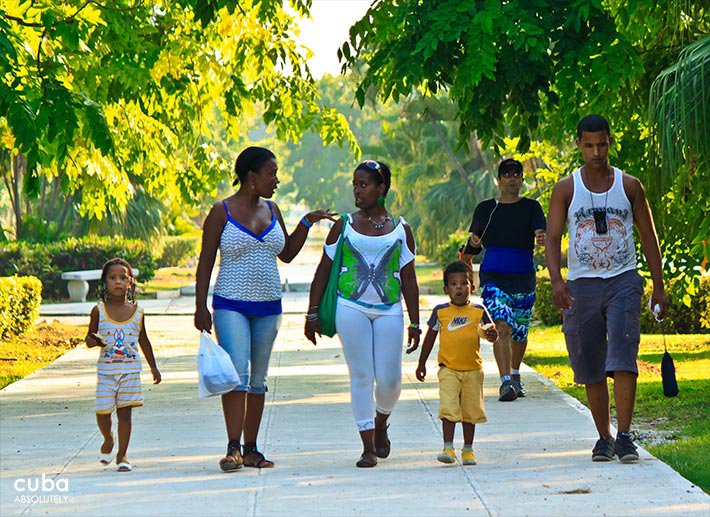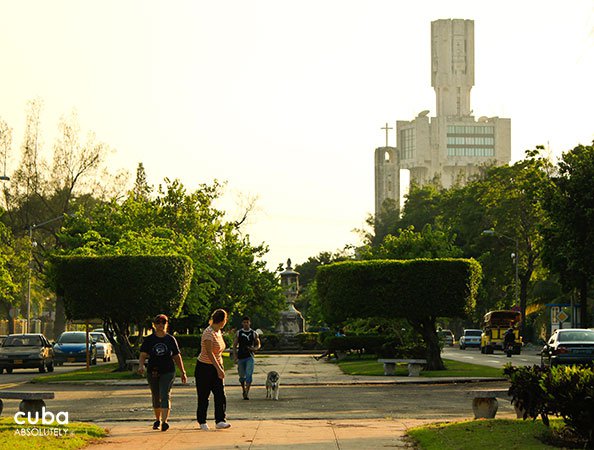
Initially called Avenida de las Américas, Quinta Avenida (Fifth Avenue) stretches from the tunnel that connects it to Calzada Street, in Vedado, to the Santa Ana River, in the locality of Santa Fe. Considered the most beautiful avenue of its time, its construction was decisive for the development of Miramar.
Havana’s Quinta Avenida
By Ricardo Alberto Pérez
For those who day after day travel from the center of Havana to the western part of the city after having fulfilled their duties of the day, beautiful and majestic Quinta Avenida, or 5th Avenue, which crosses the Miramar residential area, becomes a singular setting for meditation. For a while, it turns into a sort of singular zen garden while you drive and meditate. The beautiful surroundings and the level road make the driving soothing and help you leave the high doses of stress acquired in the urban hustle and bustle.
Cubans who for one reason or another have resided abroad, especially in South American countries, such as Brazil, have a clear awareness of the secret anguish caused by the sensation of lack of open space, which is the opposite in island nations. If we analyze in detail the structural changes that have taken place in Cuban homes in recent decades, especially those that are located in the capital, it is easy to that we are engaged in a tooth-and-nail fight to conquer more space. Fifth Avenue in particular and Miramar in general are elegies to the possibility of enjoying a space that may give the sensation of being limitless.
One of the architects involved in the construction of this important thoroughfare was one of the most famous architects in the United States at the turn of the 20th century, the American John H. Duncan, who designed the Wolcottt Hotel and Grant’s Tomb in NYC. The other architect involved was Cuban Leonardo Morales, a graduate of Columbia University. It is not by chance that Miramar with its rectangular blocks of 100 x 200 meters is so like Manhattan.
Fifth Avenue stretches down from the tunnel that connects it with Calzada Street in Vedado to the Santa Ana River in the small seaside town of Santa Fe. The road here becomes Carretera Panamericana down to El Mariel. Its layout was instrumental in the development of Miramar. Its origin goes back to the early 20th as a result of the immigration of Havana’s moneyed classes to the west beyond the mouth of the Almendares River.
The avenue’s original name was Avenida de Las Américas [Avenue of the Americas], which is why the fountain, which was inaugurated in 1924 and is situated at its very entrance, is called Fountain of the Americas. Another familiar sight on 5th Avenue is a clock tower whose four bells reproduce the sound of Big Ben in London. In 1993, the clock was declared the official symbol of tghisnterritory. These two landmarks were also built by Duncan.
Many legends and anecdotes surround this splendid avenue, most of which are connected with the mansions that were built in the area, especially in the first half of the 20th century XX, and with the people who inhabited them. One of these notable mansions is located on the corner of 5th Ave and 14th St. Ironically nicknamed “The Shack” by its owner, President Ramon Grau San Martin, the “humble” abode had 19 bathrooms, not counting the ones in the garages and pool. The mansion of the Countess of Buenavista on 5th Ave and 6th St, and which won the 1929-1930 Facade Contest of the Rotary Club, is now home to 23 different families, which make it a tenement house in one of the best residential areas in Havana. One of the most famous houses in Miramar is perhaps the one located on the corner of 5th Ave and 2nd St–The House of Green Tiles or the Green House, which for many years gave rise to numerous legends. One of these legends was that there was a treasure hidden somewhere inside the building, a myth that Luisa Rodríguez Faxas believed herself until her death. Fortunately, today the house is as a center for the promotion and study of modern architecture.
The central part of Quinta Avenida is a pedestrian walkway landscaped with bushes, flowers and trees. In the mornings, it is a place for jogging, running or working out, whether in groups or alone. In the afternoons, especially before nightfall, parents take their kids to the walkway where they can run, ride their bikes or skate.
Fifth Avenue becomes a bit foreign to itself at the roundabouts at 112th and 120th streets. Private dwellings seem to have vanished from this stretch of the avenue. The once famous Coney Island Park used to stand on the northern sidewalk. On the other side of the road, on the south side, there were seedy bars, pool rooms and nightclubs which catered, however, to all social classes. None of that exists now. The theme park Isla del Coco and the Trompoloco Circus have occupied the area of Coney Island and fast food outlets have substituted bars and nightclubs.
Walking or driving down Quinta Avenida is a treat in itself. Not only is it one of the longest arteries in Havana, it is one of the loveliest.
















 Post 1959
Post 1959





